BLADE RUNNER NEWSLETTER
YOUR FIRST SOURCE OF AREA ICE BOATING NEWS, RUMORS, & GOSSIP
Though the Four Lakes Ice Yacht Club Blade Runner Newsletter has been on haitus for several years, here is the collection of most of the entire run of the newsletter where you will find the finest writing about ice boating anywhere.
Blade Runner Archives 2001-2002
YOUR FIRST SOURCE OF AREA ICE BOATING NEWS, RUMORS, & GOSSIP
MAKING IT UP AS WE GO ALONG....FOR OVER 8 YEARS!
Best
of the Blade Runner from the 2001-2002 Season
Winter 2001, Volume 5, No. 2
Historical
Footnotes:William Perrigo's Thunderjet
Righting the Fritz
(Or How Not to Get a Big Boat Back Back on the Ice) By Don Sanford
Fall 2001, Volume 6, No. 1
Historical Footnotes: History Found by
Deb Whitehorse
What An Ice Boater Can Do When There's No Ice
Winter 2001,
Volume 6, No. 2
Three Added To Four Lakes Ice Yacht
Club Honor Roll
Winter 2002, Volume 6, No. 3
Historical Footnotes: History Found Part
II by Deb Whitehorse
HISTORICAL
FOOTNOTES
HISTORY FOUND
BY DEB WHITEHORSE
Fall 2001, Volume 6, No. 1
Last Spring while at the State Historical Society researching my family
genealogy, I discovered what has to be the most important collection of
documents relating to the early years of Madison's ice boating history.
There is a box filled with five scrapbooks crammed with articles about ice yachting in Madison, WI. The first book dates from the 1890's and was put together by Wm. Bernard, an important player in Madison's early ice yacht scene. His son Carl Bernard, a 4LIYC Honor Roll Member, continued to fill four other scrapbooks for the rest of his life. Wm. Bernard was the creator of an ice boat style named after our city, the 'Madison Style', a topic you can read about in an up-coming article.
During the summer, I studied the first two scrapbooks so that I could learn more about the Four Lakes Ice Yacht Club's history. I plan to scrutinize the other three in the coming months.
"MISCREANTS INJURE ICE YACHTS"
Controversy is nothing new to ice boating. In those days, rivalry created some animosity between Mendota and Monona skippers.
Monona and Mendota yachtsmen would begin the season racing as one club, then some dispute would cause them to revive their own separate clubs, then ice conditions would force them to sail together, and the process would repeat itself every few seasons.
Sabotage was not uncommon in those 'good old days'. One season around 1900, the Wisconsin State Journal reported that several Mendota ice boats had been tampered with while parked on Lake Monona. During the night, vandals filed down runners and snapped halyards. A "spirited" meeting was held where the "wrathy" Mendota yachtsmen charged that their boats were tampered with. Less than sympathetic remarks from a Monona skipper surely didn't help matters. Secretary Emil Fauerbach, a Monona sailor, said 'He was not sure, but some of the boatmen were mistaken about the origin of the injuries to their crafts and thought perhaps the boats were damaged by reason of contact with stones on the ice'.
The Mendota yachtsmen withdrew from the club and reorganized the Mendota Ice Yacht Club. The WSJ wrote 'The Monona sailors are not charged with the outrage but it is attributed to rowdy advocates of Monona over Mendota.'
Thankfully, the sabotaging of ice- boats is as outdated as cast iron runners.
THE MINNIE GETS IT
A hotly disputed race outcome was the basis for another split in the 1896-97 season. Mendota's Wm. Bernard, skipper of Defender, claimed that his opponent, Monona's Emil Fauerbach, skipper of the Minnie, didn't properly start a highly contested local pennant race. The victor of the race was decided at a 'rather exciting' dub meeting where the majority of the sailors in attendance had Monona loyalties and voted in favor of Fauerbach. The Mendota skippers brought an attorney to the meeting in order to argue for Bernard. Mendota skippers, outraged at the decision, decided to race only amongst them- selves again.
WHEN ICE BOAT RACING ACTUALLY PAID
Ice yacht racers often received cash and merchandise prizes for winning a race. In 1898, one local race paid the top finisher's in the A and B classes $25 and $10 respectively. There was an entry fee of fifty cents. In today currency, the entry fee would have been about ten dollars, the A class first place prize $500, and the B class first place prize $200!
Annual dues were fifty cents, (ten dollar's today), and club members were assessed a fifteen cents fee, (three dollars today), for each race even if they didn't participate.
CHARGES ARE MADE
When the cause was right, the Monona and Mendota skippers could unite, especially when publicly insulted by another ice yacht club. In 1900, The Wisconsin State Journal printed that 'Charges have been made by the [Lake] Winnebago sailors that the Madison men were inferior in their skill at handling ice boats, and the latter are anxious to demonstrate that the contrary is true.' The Oshkosh club even offered to pay the expenses of the Madison sailors if they would bring their boats to Oshkosh. If any Madison boats took up the challenge is unknown be- cause no follow up newspaper articles exist regarding the Oshkosh laying down of the gauntlet. Perhaps unfavorable conditions prevented that duel. In a few year's, all questions of yacht handling inferiority would be settled at the newly created Northwestern Ice Yacht Association annual regatta.
LOCAL MEDIA STARS
Madison's Wisconsin State Journal and Capital Times devoted much ink to the sport of ice yachting. Skippers, personalities, boats, on-ice incidents, lap-by-lap race coverage, and even club meetings were front-page sports news. In 1896, the WSJ put up a 'State Journal Cup' which was to be awarded to the winner of a series of races between Madison and Monona boats. The cup, valued at twenty-five dollars, (five hundred today), was a gold-lined solid silver trophy. Proudly displayed in the window of Nelson's jewelry store on Madison's square, the trophy was engraved 'Presented by the State Journal to the Ice Yachting Club, Madison, WI, 1896'.
Serious coverage of ice boating hasn't been seen on the sports pages of the Wisconsin State Journal since I was growing up in the 1960's. However, the most important aspects of the sport, including technical development, the search for speed, inter and in club rivalry, sportsmanship, and competition remain the same. I wonder if those skippers of one hundred years ago ever imagined that their ice boat club would still be in existence in the year 2001.
ICE
BOAT RELATED THINGS AN ICE BOATER CAN DO WHEN THERE IS NO ICE BOATING
Fall 2001, Volume 6, No. 1
While the icy chill of Winter has for the most part remained bottled up in
Alaska and Canada, (40 - 50 degrees below zero), The Southern 48 has
enjoyed not only an Indian Summer but an Indian Fall as well. Its hard to
look out over the snowless landscape and not think 'if only we'd have
colder temperatures we would be sailing right now.'
Just what can a die-hard ice yachter do to while away the time between Thanksgiving and first ice?
To help fellow skippers cope with the warm weather, (and maintain a bit of sanity), The Blade Runner offers up the following list of...
Ice Boating Related Things An Ice Boater Can Do When There Is No Ice Boating
1.Start with the obvious, work on your boat! Its been said that ice boating is 95% preparation and 5% participation. That leaves plenty of room to kick the preparation part up a few notches.
2. If just working on your boat isn't quite tripping your trigger, take the next step...build a new one!!! What makes more sense than building a new ice boat when there is no ice boating. [ I'm sure your wife will understand too.]
3. Sharpen your runners. I'm not talking about a few quick swipes over an electric belt sharpener. You have to start with a rough grit drop down to a medium grit then a fine grit, and follow with an ultra fine grit. Now get your wet stones out. Start with a rough stone then use a medium stone...
4. Start a batten 'program'. Sure, you have a set of battens in your sail. And maybe you have one or two spares molding and mildewing somewhere in your trailer. But now is the perfect time to start a batten program. You need; high wind, medium-high wind, mediums, medium-lights, light- mediums, and light-air battens in both wood and composite. Only then will you have a fairly decent start on your batten program.
5. Here's one that's sure to please your spouse. Order a new sail! Nothing beats the thrill of running a crisp and clean $1200 piece of Dacron, (or whatever they make sails out of nowadays), up a sail track for the first time. Other ice boaters gather around to watch and you can bet there'll be enough oohh's and ahh's to tide you over until next 4th of July. By the way, it's perfectly acceptable to try the new sail once, take A down, roll it up, store it away forever and run your old '86 Boston one more year. If you order a new sail every year you'll soon be on your way to starting a 'sail program'.
6. Work on your ice boat trailer. Repack the wheel bearings, maybe knock the rust off and apply a fresh coat of paint And let's be honest here, you know that all the lights haven't worked on that thing in over 20 years.
7. Build a ice boat for your kid, even if they don't want one and will never ever sail ft. Almost all serious ice boaters with kids have done this at one time or another. In about twenty years you can take it down to the swap meet and sell ft for a fraction of what it cost to build.
8. Organize a syndicate to acquire an A Boat. When there is no ice on which to sail on what could be better than getting together with your beer guzzling buddies and buying a boat that requires thicker ice?
9. Start a 'runner program'. Its been said that there are thousands of variations of ice. It only makes sense that you should strive to have a runner for every condition, 46' - quarters, 54'- 3/8's, 58'- half inchers, 58'- 3/8's, 52'- 5/16's, etc., all in hardened steel, stainless steel, and titanium. [By the way, if you have a runner, bat- ten and sail 'program' you will always have a ready excuse for not winning. Example; 'I would have won the race today but I had the wrong, (sail - runners - battens), on the boat when the (ice - wind - temperature changed.]
10. Write an article for The Blade Runner newsletter. Just think if you had only taken the time to submit something for the newsletter maybe, just maybe, ft would have replaced this obvious piece of fluff that you're wasting your time reading right now.
There you have it ten things to do while wailing for the first ice. I gotta go now, I think I hear my wife loudly wondering what's in the North Sail box the UPS guy just dropped off.
THREE
ADDED TO HONOR ROLL
Winter 2001, Volume 6, No.
2
At the January 10th meeting of the Four Lakes Ice Yacht Club the
assembled membership unanimously
voted three past or present members onto the club's Honor Roll.
Long time 4LIYC member Bill Mattison first nominated Peter Barrett for inclusion on the roll. Mattison noted Barrett, who had recently passed away, for his crewing on the historic stern steerers of the Madison area. The Fritz, the Mary B, and the Dorla were among the ice yachts that Barrett saw action on in the forties and fifties.
Greg Whitehorse then
nominated currently active Renegade sailor Jerry Simon and former club
secretary and historian, Lynn Langenfeld.
Whitehorse noted that Simon has been an active 4LIYC member for nearly
fifty years and that besides being a regatta winning champion for our
club, he has been a builder of many of the Renegade ice boats still
sailing in the Four Lakes area. Jerry has also passed his love of this
sport onto his son , Greg, who is also a regatta winning skipper.
Besides his sailing and building abilities Simon has held several positions within the club, including serving as our Commodore. He has also held many positions on the national ice boating level and is currently serving on the Renegade class technical committee.
On the nomination of Lynn Langenfeld Whitehorse said that although Langenfeld did at one time campaign a DN in our club races, her nomination to the honor roll was more for her outstanding contributions to our club in the role of historian. Lynn Langenfeld is the first woman to be placed on the 4LIYC Honor Roll.
Barrett, Simon, and
Langenfeld will join Bill Fauerbach, Carl Bernard, Andy Flom, Glen
Grosbeck, Frank Tetzloff, Spence Oswald, OT Havey, Fritz Jungbluth, John
Bluel, Dave Rosten, Walter Haspell, Jules Brockel, Charlie Johnson, Art
Jark, Harry Whitehorse, Mike McCormick, Paul Krueger, Jim Payton, Bill
McCormick, Jack Ripp, and Dave Nelson on the Four Lakes Ice Yacht Club
Honor Roll.
HISTORICAL
FOOTNOTES: THUNDER JET
The Greatest Name Ever Hung on an Ice Boat
Winter 2001, Volume 6, No. 2
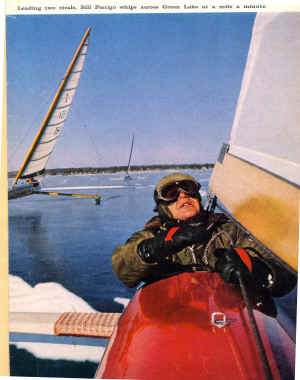
At the January 24th
meeting of the 4LIYC Tom Hyslop reported on the passing of legendary Pewaukee
ice boater, William Perrigo. Hyslop noted that it was Perrigo that brought the
classic A class stern-steerer, the Deuce, to Wisconsin from Detroit, Michigan,
and that the Perrigo family was the first family of Pewaukee Lake. Almost
'Gatsby' like was how Hyslop described the era.
The biggest house on the lake, the sleekest sail boats, and, of course, the fastest ice yachts. The whole nine yards.
When it came to ice boating, family patriarch Bill 'Curley' Perrigo was definitely what you would call 'old school'. I remember seeing him on the ice at the end of a hard day of sailing with his face bloodied and raw from being exposed to the stinging ice chips and the bitter wind. (I would be thinking to myself; 'Man, if this is what it takes, I don't know if I want to do it"!)
Popular theory in those days was that you had to feel the wind on your face in order to find the best possible way around the race course.
I don't know for sure, but I would bet that Bill Perrigo never spent much time thinking about full-face helmets, or worse, enclosed cockpits (egad!!!), on ice yachts. As far as wind chill goes... forget about it.
Perrigo was more than a tough ice boater however, he was a damn good one too. Regatta wins in both the Northwestern and the ISA, along with victories in the Ice Yacht Challenge Pennant of America races, would appear on his ice yachting resume before he hung up his goggles for good.
His championship winning E Skeeter back in the fifties and early sixties had what I always considered to be the greatest name ever hung onto an ice yacht, Thunder Jet
Nearly forty years have passed since the last time I've seen that boat on the ice, and yet the name Thunder Jet can still stir up images of a fleet of bright white sails flying over a frozen surface at some long ago regatta.
Thunder Jet, as I was to learn later listening to the stories Bill Mattison, Jack Ripp, and others would tell of our sport's past, was really one tank of an Skeeter ice boat. Built heavy to begin with, on windy days its sleek fuselage was further strained by the rumored hundreds of pounds of lead that Perrigo would casually toss in the cockpit before shoving off. Thunder Jet was not built for gentle breezes, it wasn't made for medium conditions, and 'building for the average' wasn't part of the game plan. Thunder Jet was built for when the wind was howling and it took a genuine set of brass ones to park your butt in a Skeeter ice boat and yank really hard on the go fast rope.
As legend has it, Perrigo's Thunder Jet was always the last boat off the starting line and usually the last boat to round the top mark. The quicker, (but not necessarily faster), Skeeters would jump out to what seemed to be insurmountable leads. But if it was windy enough soon Thunder Jet could be seen ripping through a fifty boat field like a sharp saw blade through dry sitka.
By the second lap Perrigo would be mid-pack, by the third he'd be battling for the lead, and by the last lap Perrigo and Thunder Jet would be showing a rapidly disappearing stern to the rest of the frustrated Skeeter fleet.
Even though thirty-five mph wind speeds were perfectly acceptable in those days, most regattas weren't sailed in hurricane like conditions.
But apparently a few were, as Perrigo captured three Northwestern Regatta titles, (1950, 1952, and 1958), two International Skeeter Association championships, (1958 and 1964), to go along with three successful efforts in the Ice Yacht Challenge Pennant of America series, (1953, 1955, and 1961).
One of Bill Perrigo's last great ice yachting triumphs came in the Challenge Pennant races sailed on Lake Mendota in March of 1970.
The 4LIYC had won the Pennant in 1964, and successfully defended it for the next five years. Indeed, few thought that the Pennant races of 1970 would produce anything other than a 7th straight 4LIYC victory.
But the Pewaukee Ice Yacht Club had different ideas.
In their bid to wrestle the Pennant away from the 4LIYC, Pewaukee decided to send Art Jark's lightening fast, ex-Bill Mattison Honeybucket, now named the Nancy E III, to Madison as one of it's challenging yachts.
And Art Jark promptly tapped Bill Perrigo to steer ft.
The Pennant title came down to the last race of the series that year. 4LIYC's Dave Rosten, expertly piloting his Skeeter, Pirate, appeared to be headed for victory. But as the long, ten lap, twenty mile race wound down the wind began to pick up. The light snow that had fallen on and off throughout the day began to be blown around at the ice surface.
Soon the swirling snow built to almost surreal white-out conditions. All you could see of the boats racing around the course were the top four or five feet of the mast and sail. Finding the marks in these unbelievably dangerous conditions was next to impossible. On the last lap of the race Rosten could not find the top mark.
Somehow, Perrigo did.
A few minutes later the race scorers and other on-lookers were shocked to see Jark's V-69, with Bill Perrigo at the helm, streaking toward the finish line.
The Ice Yacht Challenge Pennant of America went to Pewaukee.
Yeah... under the toughest of conditions Bill Perrigo proved how tough he was.
And damn good too
Historical Footnotes:
HISTORY
FOUND- PART 2
By Deb Whitehorse
Winter 2002, Volume
6, No. 3
Editor’s note; In the Fall 2001 issue of The Blade Runner 4LIYC Secretary, Deb Whitehorse, introduced us to the first (of five) scrapbooks from turn of the century (the 19th to the 20th), Madison ice yachters, Wm. and Carl Bernard. Here now is the second installment of History Found.
The vast amount of press indicates that Madison ice yachting coverage must have sold newspapers. That many of the participants were prominent citizens of the era surely helped to insure ice yachting’s importance on the sports page. Such names include the Fauerbach family, one of Madison’s premier brewing dynasties, Wisconsin State Journal editor H.A. Taylor, Madison hoteliers the Fess family, Wisconsin Governor Upham, Wisconsin Senator Spooner, and Wisconsin Supreme Court Justice Winslow.During the time span of 1910 thru 1913, there were three Madison ice boat clubs, The Mendota Ice Yacht Club, the Monona Ice Yacht Club, and the newly formed Mendota Yacht Club.
YACHTSMEN DISAGREE
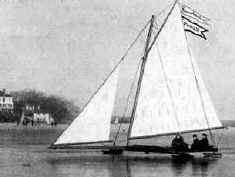
When the ice yachts raced, crowds of six hundred spectators were commonplace and passenger trains on their way out of town would stop on the tracks next to Lake Monona to watch the excitement. Two famous Madison ice boaters were asked to give their opinion on the enforcement of a city ordinance which prohibited the yachts to sail closer than a third of a mile from the shoreline when sailing in the city limits. Emil Fauerbach, owner of the fabled Princess boats, and Wm. Bernard, the premier boat builder of the day, had differing views in regard to the law. Bernard, an early proponent of less government in this matter, felt the law was "unjust to ice boat owners". Citing safety concerns, Fauerbach supported the rule. Though Bernard built and often sailed Fauerbach’s ice boats, there was quite a sense of rivalry between the two. It is likely that these two competitors agreed to disagree about most every subject, particularly when quoted in the newspaper.
The
Cold War:
The Hudson River Style vs.
The Madison Style
The most passionate debate of the day was between proponents of a Eastern style ice boat and those who favored a boat developed by Wm. Bernard, called the Madison style. Long the favorite boat of the eastern ice boat establishment, the Hudson River style was designed to race the long stretches of New York’s Hudson River. Bernard’s Madison style differed with a long bow sprit out front, a shorter backend, a trussed plank, and a raked mast.
In a interview in The Blade Runner published a few years ago, Jack Ripp, longtime 4LIYC member, and ice boating champion, recalled that Madison style boats "were the worst...... just asking for a spin." He related that when he was a kid, he bought one for fifteen dollars and that every time it hiked, " you could bet fifty dollars that as soon as the runner came down on the ice, you were going to spin."
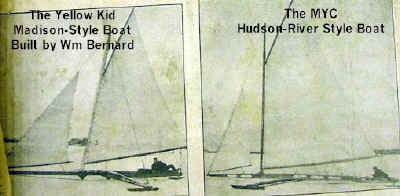
Money Raised for Giant Ice Yacht
At the first annual banquet of the Mendota Yacht Club on November 2, 1911, one hundred dollars ($1700 in today’s dollars) was raised amongst seventy attendees for the purposes of a syndicate to purchase of the "largest craft [ice boat] ever seen in the west." The club ordered a design from H. Percy and A. Shely of New York for a Hudson River racer. The boat was designed to carry 450 square feet of canvas, 36 feet in length with a 22 foot runner plank. J.O. Goss of Detroit furnished the sails and Poughkeepsie’s George Buckhout furnished the "natural bend basswood plank and the runners." Mendota Yacht Club members felt the Hudson River type superior to the Madison style and wanted to prove it in a big way with the yacht they christened MYC. Madison’s most famous ice yacht builder, Wm. Bernard, was not in attendance at that banquet. Bernard’s collection of newspaper clippings don’t include any personal observations, but one can imagine that he looked forward to the challenge to prove himself.
In early December of 1912, the Wisconsin State Journal reported that "work is being rushed on a runner plank down at the Frederickson Mill" for the MYC, the largest ice yacht ever constructed in Madison.
The MYC made her long awaited racing debut on Lake Mendota in late February of 1913. The State Journal reported "That the new MYC did not get to prove her worth yesterday after breaking down in the initial race. A smashed jib traveler and loss of a bowstay block put her out of the running." It was a big disappointment for those who expected her to make a sweep. The MYC’s less than stellar performance wasn’t a total victory for Bernard because the Hudson River types beat out the Madison styles, including Fauerbach’s legendary Princess, during that weekend series of racing. The Princess would eventually go on to win the Northwestern Regatta and the Hearst Cup.
The MYC was plagued with problems throughout her sailing career. Some wags, no doubt Madison Style fans, snidely referred to her as the YMCA, noting that she couldn’t point on the beat. Twice remodeled, the last time in December of 1914, the MYC was deemed by the Wisconsin State Journal to have never been a success "because her eastern designer and the local boat builder tried too hard to save weight. The boat was therefore not strong and stiff enough to stand the heavy grind of sailing on large and open lakes." Also noting, "Her sails, built by a Detroit firm, never set well."
In the end of the big boat era, when the last of the Madison stern-steerers were built in the 1930’s and 1940’s the Hudson River style was the boat of choice.
Modern ice boaters continue to thrive on controversy, and today many debate the merits of the front-seater vs. the rear-seater Skeeter just as their predecessors did with the various ice yacht designs one hundred years ago.
RIGHTING THE FRITZ
(Or how not to get a big
boat back on the ice)
By Don Sanford
Winter 2001, Volume 5, No. 2
The last weekend in
January was some of the best desperation iceboating I've done in a long
time! The conditions weren't great, but they were at least conditions. We
could drive onto the ice in front of Chuck's in Fontana so that was a
plus. The ice was a big rough, but at least it was ice, which was also a
plus. Oh, there was wind, plenty of wind, another plus or so we all
thought.
A race course had been staked out at the east end of Lake Geneva. The trip down there in a Nite from Fontana was bearable if you kept your speed down and steered around the bumps. The big boats were racing for the Hearst or was it the Wisconsin Stern Steerer Association Championship or both. Watching those monsters take the bottom mark, sometimes spinning out but always chewing up clouds of snow an dice chunks was a thrill. Racing our Nites in that stuff was a real challenge I felt like a fish in a blender after the first race. Come to think of it, I can't remember if we actually had a second race.
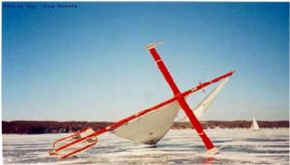
Just
as we got ready to go home, Don Anderson looked up the lake and noticed
that one of the big boats had turned over near the top mark. We had
already seen a side-by-side Skeeter break in two on the race course during
the last lap. We decided it might be wise to put an end to the damage to
ourselves and the boats and head in. By the time we arrived at the top
mark, a C boat had joined the Fritz. A spinning C boat turned out to be no
match for the bulk of the Fritz and it was reduced to rubble. Amazingly
there were no injuries other than to the egos of the skippers and crews.
The assembled crowd now turned our attention to getting the Fritz back on the ice. That runner plank stood up like Moby Dick's tail just before he took out the Pequod. We all figured it would be just as dangerous once we started a rescue mission. I've never had the experience of getting a big boat back o her feet so I just stood there with everyone else trying to get a grip on the situation. That's when Buddy arrived. He sized up the situation in a jiffy, assigned someone to toss a line over a framing stay and instructed the rest of us to turn her into the wind. After discussing which we we'd run to as not be crushed like bugs when she came back o the ice, we began to pull.
With the aid of at least a
dozen guys, gravity began to take its predicted effect and 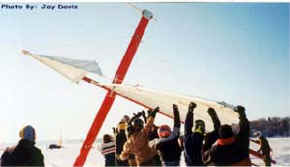
themighty Fritz passed the balance point and headed back to her normal
sailing position. Unfortunately,
the touchdown was a bit harder than anticipated and a crack appeared in her
runner plank. On the positive side though, she was back on the ice and no one
was either crushed or run over.
At lunch that afternoon I sat down with Bill Mattison, Bill Hansen, Paul Krueger, and Ken Kreider. 'Could you stop at the shop on your way home?' Bill asked. 'We've got a little project and we'll need some help.' Paul added. Later that day five of us, (it would have been easier with six) unloaded the big plank at Bill Mattison's shop. By the end of the week Bill and his helpers had introduced glue and clamps at the appropriate places and repaired the damage. The Fritz was back on the ice just in time for the Northwest.
Next time I see one of these big boats in a non-sailing position, I'll think about how one might over come the likely effects of gravity while outwitting the laws of physics


